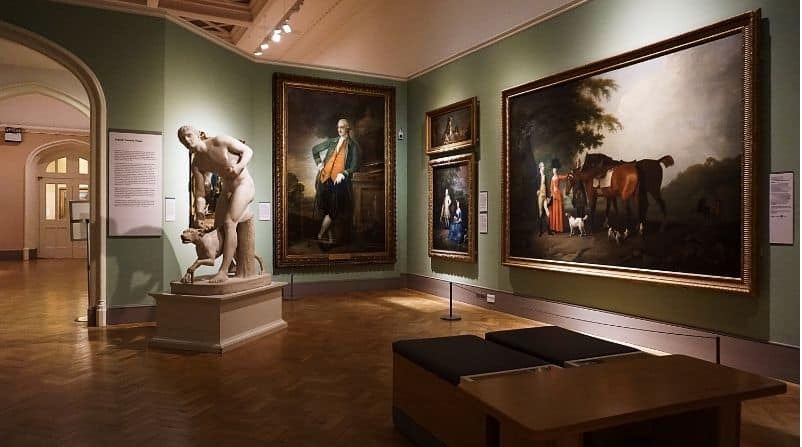It may come as a surprise that many of your favorite artist’s pieces are probably being stored away in art metal warehouses, even works of art that are considered masterpieces.
There are two main reasons for this massive art storage phenomenon:
There is a lot that goes into the preservation and storage of these magnificent artworks from the warehouse in which the art is stored (usually a metal warehouse), the cold storage and humidity control technology, and top of the line security.
First, let’s look at how we got to so much of our favorite art pieces being tucked away in metal warehouses.
When thinking of non-profit art museums the MET, MoMA, or the Louvre may come to mind, each one uniquely curated with the most renowned breathtaking art exhibits for the public’s enjoyment. Surprisingly, the public is only seeing a small fraction of the pieces owned by these art museums. It is estimated that only 5% of the art owned by art museums is ever seen by the public eye. The rest are tucked away in metal warehouses!
The main reason for this massive art museum storage is that these non-profit art museums are prohibited from selling any of the pieces they own. Many artists and art collectors are drawn to donating their artwork to these art museums because they have these no resale policies.
Like we said before only a select few works of art are rotated depending on the museum’s current art exhibits. Unfortunately, this leaves most artworks tucked away in massive storage warehouses, never to be seen by the public eye.
Listed below is a breakdown of the main reasons for art museum storage:
Who is mainly to blame for this intense hoarding? Well, we can look to conservatives within the art industry who believe a museum’s main duty is to preserve the artwork they own.
However, progressive ideas are shaking this standard. Stating that the non-profit museum’s main purpose should be to serve the public. Hence, they should be displaying more artwork and selling or renting their pieces in warehouse storage to other smaller museums. This would allow the smaller museums to display these tucked away pieces of art and the “seller/renter” museum to have the financial ability to provide free access to the public.
We can’t just blame art museums for so much of the world’s art being stored away in these metal warehouses. We also need to consider the explosion of the global art market during the last couple of decades. Again, these artworks are not up for display in extravagant homes but stored securely inside boxes within a massive metal warehouse as they increase in value. Since these masterpieces are mainly seen as capital assets for many of the owners the main incentive is to make sure they are perfectly preserved when sold.
These massive metal warehouses are known as free ports, they located are worldwide, the biggest ones are estimated to store up to billions of dollars in art. Free ports are legally defined as free trading zones, where the art that is there has not technically entered the US. Free ports are technically offshore, not residing in any country at all, allowing these art buyers and sellers to delay taxation (import and export taxes do not apply).

These valuable art pieces (paintings, leather artwork, photographs, wooden pieces) require specific storing requirements within these metal warehouses due to their sensitivity to the environment. They are susceptible to being damaged or destroyed if stored for extended periods of time in places without temperature and humidity control.
Cold storage is the storage of any temperature-controlled product that reduces the risk of damage to the product, extends its shelf life, and keeps the product in line with regulations.
In this instance, cold storage technology is to keep the warehouse’s temperature at a cooler range (68-72 degrees Fahrenheit) to protect the art from any heat damage. These warehouses also come installed with 24/7 temperature scans to make sure they adhere to the stringent temperature requirements. On top of that, the air-conditioning system is also designed to filter the air multiple times a day.
Humidity controllers are also used throughout the whole steel warehouse to keep humidity between 50 – 55 percent. Most warehouses use an eco-friendly way of controlling humidity, called “atomization”, also known as reverse osmosis. Atomizers use a fine-spray nozzle to “atomize” the regular tap water (which is dechlorinated and softened). As the atomized water passes the chamber heater, it becomes heated to a gas.

Storm Surge Protection is also needed depending on the location of the warehouse. To protect from any potential water damage these warehouses come equipped with protective panels. The walls are built with insulated metal panels on both the inner and outer walls, protecting the warehouse from any hazardous weather elements.
Generators are always incorporated into the warehouse design. In case of any potential power outages, these warehouses have multiple generator backups. These generators also run on natural gas to make sure no disaster will stop the warehouse from running properly.
As you can see from above these warehouse designs have covered every aspect of protecting these works of art. These warehouses even have completely enclosed loading docks. So there is no potential weather damage when moving any of the art.
It doesn’t come as a surprise that these warehouses have some of the most intense security. In some art storage warehouses, people who wish to enter the warehouse require a retina scan as well as other forms of identification. The metal warehouses are being guarded 24/7 by trained security guards and have the most advanced security technology including:
These art storage warehouses truly have been transformed into “bulletproof“ forts.

A lot happens within these metal buildings, there are professionals conducting art preservation, art collectors and owners showcasing their art collections to prospective buyers, and all-around warehouse management.
To accommodate for these varying needs multiple private rooms, as well as larger showrooms, are built into the bottom floor of these warehouses to conduct art trade and preservation.
We love learning at MBMI, especially about the wide range of industries that use metal warehouses. Who knew that your favorite Picasso is probably safely tucked away in a steel building.